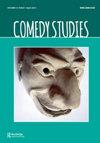讽刺和滑稽笑声的问题
Q1 Arts and Humanities
引用次数: 5
摘要
当代美国流行文化中讽刺作品的无所不在,为这种特殊的喜剧作品的理论提供了一个开放的空间。除了概述讽刺作品出现的必要因素外,我还提供了一些关于研究领域的理论评论——幽默研究通常被称为幽默研究,我称之为喜剧事业。为了探究讽刺的本质以及观众和读者对讽刺的接受程度,本文探讨了喜剧笑声的潜在意义。本文章由计算机程序翻译,如有差异,请以英文原文为准。
Satire and the problem of comic laughter
Abstract The ubiquity of satire in contemporary American popular culture suggests an opening for contributing to theory about that particular kind of comic artefact. In addition to a sketch of the necessary elements for satire to appear, I offer some theoretical remarks about the field of study—humor studies as it is usually called, The Comic as I term the enterprise. Potential meanings of comic laughter are explored in order to probe the nature of satire and its reception by audiences and readers.
求助全文
通过发布文献求助,成功后即可免费获取论文全文。
去求助
来源期刊

Comedy Studies
Arts and Humanities-Literature and Literary Theory
CiteScore
0.60
自引率
0.00%
发文量
26
 求助内容:
求助内容: 应助结果提醒方式:
应助结果提醒方式:


